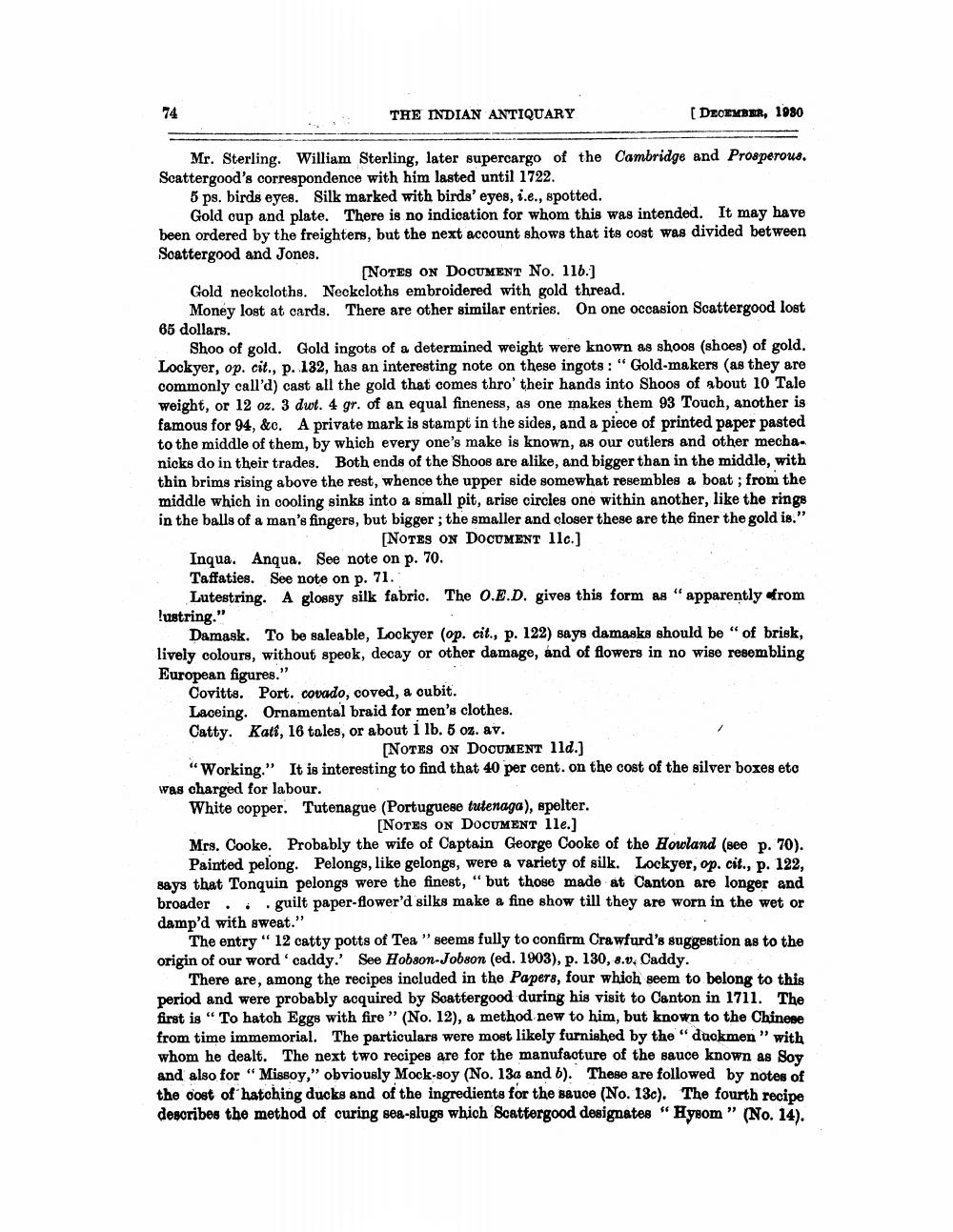________________
THE INDIAN ANTIQUARY
DECEMBER, 1980
Mr. Sterling. William Sterling, later supercargo of the Cambridge and Prosperous. Scattergood's correspondence with him lasted until 1722.
5 ps, birds eyes. Silk marked with birds' eyes, i.e., spotted.
Gold cup and plate. There is no indication for whom this was intended. It may have been ordered by the freighters, but the next account shows that its cost was divided between Soattergood and Jones.
(NOTES ON DOCUMENT No. 116.] Gold neckcloths. Neckcloths embroidered with gold thread.
Money lost at cards. There are other similar entries. On one occasion Scattergood lost 65 dollars.
Shoo of gold. Gold ingots of a determined weight were known as shoos (shoes) of gold. Lockyer, op. cit., p. 132, has an interesting note on these ingots: "Gold-makers (as they are commonly call'd) cast all the gold that comes thro' their hands into Shoos of about 10 Tale weight, or 12 oz. 3 dwt. 4 gr. of an equal fineness, as one makes them 93 Touch, another is famous for 94, &c. A private mark is stampt in the sides, and a piece of printed paper pasted to the middle of them, by which every one's make is known, as our cutlers and other mecha. nicks do in their trades. Both ends of the Shoos are alike, and bigger than in the middle, with thin brims rising above the rest, whence the upper side somewhat resembles a boat; from the middle which in cooling sinks into a small pit, arise circles one within another, like the rings in the balls of a man's fingers, but bigger; the smaller and closer these are the finer the gold is."
(NOTES ON DOCUMENT llc.) Inqua. Anqua. See note on p. 70. Taffaties. See note on p. 71.
Lutestring. A glossy silk fabrio. The O.E.D. gives this form as "apparently from lustring."
Damask. To be saleable, Lockyer (op. cit., p. 122) says damasks should be " of brisk, lively colours, without speck, decay or other damage, and of flowers in no wise resembling European figures."
Covitta. Port. covado, coved, a oubit. Laoeing. Ornamental braid for men's clothes. Catty. Kati, 16 tales, or about 1 lb. 5 oz. av.
(NOTES ON DOCUMENT 1ld.) "Working." It is interesting to find that 40 per cent. on the cost of the silver boxes eto was charged for labour. White copper. Tutenague (Portuguese tutenaga), spelter.
[NOTES ON DOCUMENT lle.] Mrs. Cooke. Probably the wife of Captain George Cooke of the Howland (see p. 70).
Painted pelong. Pelongs, like gelongs, were a variety of silk. Lockyer, op. cit., p. 122, says that Tonquin pelongs were the finest, “but those made at Canton are longer and broader. guilt paper flower'd silks make a fine show till they are worn in the wet or damp'd with sweat."
The entry "12 catty potts of Tea " seems fully to confirm Crawfurd's suggestion as to the origin of our word 'caddy.' See Hobson-Jobson (ed. 1903), p. 130, 8.0. Caddy.
There are, among the recipes included in the Papers, four which seem to belong to this period and were probably acquired by Seattergood during his visit to Canton in 1711. The first is "To hatoh Eggs with fire ” (No. 12), a method new to him, but known to the Chinese from time immemorial. The particulars were most likely furnished by the "duokmen " with whom he dealt. The next two recipes are for the manufacture of the sauce known as Soy and also for "Missoy," obviously Mock-soy (No. 13a and b). These are followed by notes of the cost of hatching ducks and of the ingredients for the sauce (No. 13c). The fourth recipe describes the method of curing sea-slugs which Scattergood designates "Hyeom " (No. 14).




